
The 608 area code covers much of southwestern Wisconsin, including the capital city of Madison as well as the cities of Waunakee, Mount Horeb, Verona, Sun Prairie, Monroe, Platteville, Lancaster, Lodi, Portage, Baraboo, Wisconsin Dells, Beloit, Janesville, La Crosse, Prairie du Chien, Prairie du Sac, Sauk City, Viroqua and Sparta. It was created in 1955 as a split from area code 414, and was the third area code created in Wisconsin.
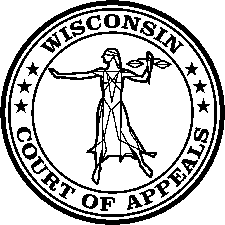
The Wisconsin Court of Appeals is an intermediate appellate court which reviews contested decisions of the Wisconsin circuit courts. The Court of Appeals was created in August 1978 to alleviate the Wisconsin Supreme Court's rising number of appellate cases. Published Court of Appeals opinions are considered binding precedent until overruled by the Supreme Court; unpublished opinions are not. The Court hears most appeals in three-judge panels, but appeals of circuit court decisions in misdemeanor, small claims, and municipal ordinance cases are decided by a single judge.
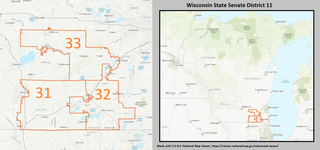
The 11th Senate District of Wisconsin is one of 33 districts in the Wisconsin State Senate. Located in southern Wisconsin, the district comprises most of Walworth County, the eastern half of Rock County, parts of the southern half of Jefferson County, southwest Waukesha County, and western Kenosha County.

Harry Chapman Martin was a lawyer, educator and politician from the U.S. State of Wisconsin. He served as mayor of Darlington, and later as a member of the Wisconsin State Assembly and the Wisconsin State Senate.

The 14th Senate District of Wisconsin is one of 33 districts in the Wisconsin State Senate. Located in central Wisconsin, the district comprises Green Lake and Marquette counties, and most of Columbia and Waupaca counties, as well as the southern half of Adams County, the eastern half of Waushara County, northwest Dodge County, western Fond du Lac County and parts of northeast Sauk County, northern Dane County, and western Outagamie County.

The 15th Senate District of Wisconsin is one of 33 districts in the Wisconsin State Senate. Located in southern Wisconsin, the district comprises western Rock County, southeast Green County, and parts of southeast Dane County, Southwest Jefferson County, and northwest Walworth County. It includes most of the city of Janesville and the western part of the city of Beloit, as well as the cities of Brodhead, Edgerton, Evansville, Milton, and Whitewater.

The 22nd Senate District of Wisconsin is one of 33 districts in the Wisconsin State Senate. Located in southeast Wisconsin, the district comprises parts of eastern Kenosha and Racine counties, including most of the cities of Racine and Kenosha, and parts of the villages of Mount Pleasant and Somers, east of Wisconsin Highway 31.
The 28th District of the Wisconsin Senate is located in Southeastern Wisconsin, and is currently composed of parts of Milwaukee, Waukesha, Racine, and Walworth counties. During the late 19th and early 20th century, it was located around Richland County, Wisconsin and neighboring counties.

There are a variety of schema for dividing Wisconsin into regions.
The Fifteenth Wisconsin Legislature convened from January 8, 1862, to April 7, 1862, in regular session, and re-convened from June 3, 1862, through June 17, 1862. The legislature further convened in a special session from September 10, 1862, through September 26, 1862.

The 50th Assembly District of Wisconsin is one of 99 districts in the Wisconsin State Assembly. Located in central Wisconsin, the district comprises all of Juneau County, and parts of north and central Richland County, northern Sauk County, eastern Vernon County, and southeast Monroe County. It includes the cities of Elroy, Mauston, New Lisbon, Reedsburg, and Richland Center, as well as the villages of Camp Douglas, Cazenovia, Kendall, La Valle, Loganville, Lyndon Station, Necedah, Rock Springs, and Wonewoc. The district also contains landmarks such as the Necedah National Wildlife Refuge, Buckhorn State Park, the Dell Creek State Wildlife Area, the eastern half of Mill Bluff State Park, and the Volk Field Air National Guard Base. The district is represented by Republican Tony Kurtz, since January 2019.
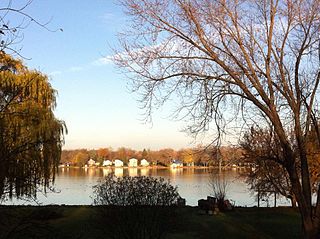
The 61st Assembly District of Wisconsin is one of 99 districts in the Wisconsin State Assembly. Located in southeastern Wisconsin, the district covers most of Kenosha County. It includes the villages of Bristol, Paddock Lake, Pleasant Prairie, Salem Lakes, and Twin Lakes, and the western half of the village of Somers. It also contains the Richard Bong State Recreation Area and Chiwaukee Prairie Nature Preserve. The district is represented by Republican Samantha Kerkman, since January 2013.

The 66th Assembly District of Wisconsin is one of 99 districts in the Wisconsin State Assembly. Located in southeast Wisconsin, the district covers most of the city of Racine, Wisconsin, including downtown Racine and Racine Harbor and landmarks such as the Racine Art Museum, Old Main Street Historic District, Historic Sixth Street Business District, the Racine Zoo, Memorial Hall, and Johnson Wax Headquarters. The district is represented by Democrat Greta Neubauer, since January 2018.
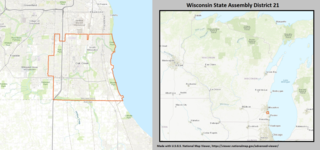
The 21st Assembly District of Wisconsin is one of 99 districts in the Wisconsin State Assembly. Located in southeastern Wisconsin, the district covers the southeast corner of Milwaukee County, including all of the suburban cities of Oak Creek and South Milwaukee, as well as a few blocks of the neighboring city of Franklin. The district is represented by Republican Jessie Rodriguez, since winning a special election in November 2013.

The 31st Assembly District of Wisconsin is one of 99 districts in the Wisconsin State Assembly. Located in southern Wisconsin, the district comprises southeast Rock County and southwest Walworth County. I includes the city of Elkhorn and part of the cities of Janesville and Beloit, as well as the villages of Clinton, Darien, Fontana-on-Geneva Lake, Sharon, Walworth, and Williams Bay. The district is represented by Republican Amy Loudenbeck, since January 2013.

The 39th Assembly District of Wisconsin is one of 99 districts in the Wisconsin State Assembly. Located in east-central Wisconsin, the district comprises most of the eastern half of Dodge County and part of the city of Hartford in western Washington County. It also includes the cities of Beaver Dam, Horicon, Juneau, and Mayville, and the villages of Brownsville, Clyman, Hustisford, Kekoskee, Lomira, Neosho, and Theresa, and contains half of the Horicon Marsh State Wildlife Area. The district is represented by Republican Mark Born, since January 2013.

The 45th Assembly District of Wisconsin is one of 99 districts in the Wisconsin State Assembly. Located in southern Wisconsin, the district comprises most of eastern Green County and western and southwestern Rock County. It includes the western half of the city of Beloit, the cities of Evansville and Brodhead, and the villages of Albany and Orfordville. It also contains Beloit College. The district is represented by Democrat Mark Spreitzer, since January 2015.

The 47th Assembly District of Wisconsin is one of 99 districts in the Wisconsin State Assembly. Located in south-central Wisconsin, the district comprises municipalities in south-central Dane County, including the city of Monona, the village of McFarland, and the northern half of the city of Fitchburg. It also contains the Capital Springs State Recreation Area, the Pflaum-McWilliams Mound Group, and the Alliant Energy Center. The seat is represented by Democrat Jimmy P. Anderson since January 2017.

The 49th Assembly District of Wisconsin is one of 99 districts in the Wisconsin State Assembly. Located in southwest Wisconsin, the district comprises all of Grant County, as well as most of the western half of Richland County and a small part of southwest Lafayette County. It includes the cities of Boscobel, Cuba City, Fennimore, Lancaster, and Platteville, and the villages of Benton, Bloomington, Blue River, Boaz, Cassville, Dickeyville, Hazel Green, Livingston, Montfort, Muscoda, Potosi, Woodman, and Yuba, and the part of the village of Viola within Richland County. The district also contains the University of Wisconsin–Platteville campus, Wyalusing State Park, and Nelson Dewey Memorial State Park, and historic landmarks such as the Potosi Brewery and the Grant County Courthouse. The district is represented by Republican Travis Tranel, since January 2011.
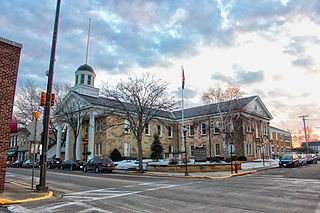
The 51st Assembly District of Wisconsin is one of 99 districts in the Wisconsin State Assembly. Located in southwest Wisconsin, the district comprises most of Lafayette County, as well as southwest Green County, central and western Iowa County, southeast Richland County, and southwest Sauk County. It includes the cities of Darlington, Dodgeville, Mineral Point, Monroe, and Shullsburg, and the villages of Argyle, Avoca, Belmont, Cobb, Gratiot, Highland, Lime Ridge, Lone Rock, Plain, Rewey, and Spring Green. It also contains landmarks such as Frank Lloyd Wright's Taliesin estate, the historic Iowa County Courthouse, Governor Dodge State Park, Yellowstone Lake State Park, and Cadiz Springs State Recreation Area. The district is represented by Republican Todd Novak, since January 2015.



















